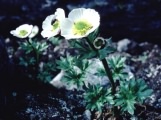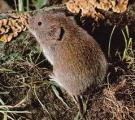 |
|
|
|
|
|
|
Susceptibility We have seen that the distribution of herbivory in alpine ecosystems is often
very patchy. However, in areas where herbivores are abundant, plant traits such as
growth form determine the quantities and types of plant material which are
taken as food. Many herbaceous plants in the alpine environment have a rosette-like growth form for
large parts of the growing season, which makes them hardly accessible to large herbivorous mammals. In spite of the harsh environment, many alpine plants appear to be able to lose a substantial fraction of their annual leaf crop to natural herbivores with no apparent effect on their performance. Some species are even able to overcompensate for lost tissue. In lowlands, loss of tissue due to herbivory often means a reduction of competitive ability; in the alpine environment, this may be less important and thus plants may be less susceptible to herbivory. Yet, under continued high herbivore pressure, the storage tissues of plants are depleted, which reduces their fitness in the long term. |
|
Reproduction Herbivory may be devastating for reproduction because many alpine plants exhibit bud preformation, i.e. the development of leaves and/or flowers may take several years. If these organs are removed, the plant has no possibility to compensate for this removal within the same season and maybe even for several seasons. |
1 - Polygonum viviparum (63K) |
|
Variations in herbivory may greatly add to the high year-to-year variability in seed set known for many alpine plants. For example, in Ranunculus glacialis, growing at the upper altitudinal limit of vascular plants in the Swiss Alps, seed production seems to be modified more by herbivory than by climatic variation. This is because the main herbivore of R. glacialis, the snow vole (Microtus nivalis), is more active in cool years with an abundant snow pack. |
|
2 - Ranunculus glacialis (87K)
|
3 - Microtus nivalis (38K)
|
|
Plants with a rosette-like growth form in spring but upright generative shoots (with leaves) in summer are more likely to be eaten later in the season due to their higher accessibility and an often high P content during flowering. It might be expected that seed predation and herbivory of seedlings would further decrease the success of sexual reproduction in alpine environments. However, since it is mainly the less abundant invertebrate herbivores that attack seedlings, it is possible that a higher proportion of seedlings escape herbivory than in the lowland. |
29 August 2011 |
||
| |
||


